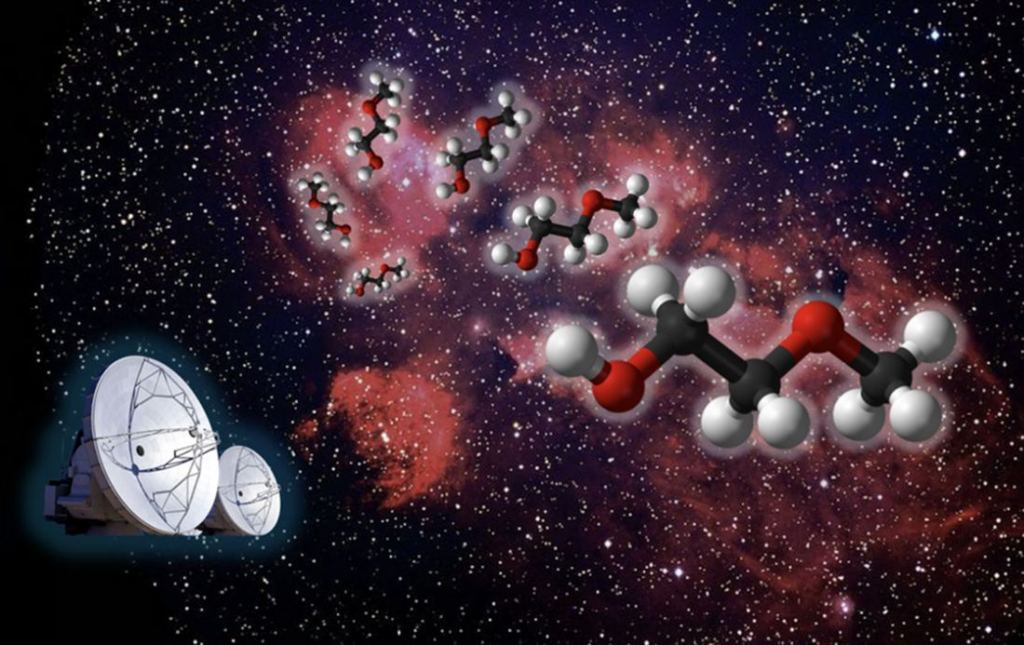Another New Molecule Discovered Forming in Space
By Evan Gough
The list of chemicals found in space is growing longer and longer. Astronomers have found amino acids and other building blocks of life on comets, asteroids, and even floating freely in space. Now, researchers have found another complex chemical to add to the list.
The new chemical is known as 2-methoxyethanol (CH3OCH2CH2OH). It’s one of several methoxy molecules that scientists have found in space. But with 13 atoms, it’s one of the largest and most complex ones ever detected.
A team of scientists called the McGuire Group specializes in detecting chemicals in space. The McGuire Group and other researchers from institutions in Florida and France worked together to find 2-methoxyethanol.
The researchers published their findings in The Astrophysical Journal Letters. It’s titled “Rotational Spectrum and First Interstellar Detection of 2-methoxyethanol Using ALMA Observations of NGC 6334I.” The lead author is Zachary Fried, a graduate student in the McGuire Group at MIT.

“There are a number of ‘methoxy’ molecules in space, like dimethyl ether, methoxymethanol, ethyl methyl ether, and methyl formate, but 2-methoxyethanol would be the largest and most complex ever seen,” said lead author Fried.
The researchers didn’t stumble upon the large molecule. It was found as part of a concerted effort to detect new chemicals in space. It all started with machine learning. In 2023, one machine-learning model suggested they look for 2-methoxyethanol. The next step was the lab, where researchers performed experiments that measured and analyzed the molecule’s rotational spectrum here on Earth.
“We do this by looking at the rotational spectra of molecules, the unique patterns of light they give off as they tumble end-over-end in space,” said Fried. “These patterns are fingerprints (barcodes) for molecules. To detect new molecules in space, we first must have an idea of what molecule we want to look for, then we can record its spectrum in the lab here on Earth, and then finally we look for that spectrum in space using telescopes.”
The researchers measured the molecule’s spectrum over a broadband region of frequencies ranging from the microwave to sub-millimetre wave regimes (from about 8 to 500 gigahertz).
With that data in hand, the researchers turned to ALMA, the Atacama Large Millimetre/sub-millimetre Array. ALMA gathered data from two star-forming regions: NGC 6334I and IRAS 16293-2422B. Researchers from the McGuire Group, the National Radio Astronomy Observatory, and the University of Copenhagen all worked on analyzing ALMA’s observations.
“Ultimately, we observed 25 rotational lines of 2-methoxyethanol that lined up with the molecular signal observed toward NGC 6334I (the barcode matched!), thus resulting in a secure detection of 2-methoxyethanol in this source,” said Fried. “This allowed us to then derive physical parameters of the molecule toward NGC 6334I, such as its abundance and excitation temperature. It also enabled an investigation of the possible chemical formation pathways from known interstellar precursors.”

Here on Earth, 2-methoxyethanol is used mostly as a solvent. It’s toxic to bone marrow and testicles. But its status here on Earth isn’t relevant to its discovery.
The large molecule isn’t a building block for life, either. It’s significant because of its size and complexity. Scientists are interested in understanding how chemistry evolves and forms large molecules in regions where stars and planets are forming.
“Our group tries to understand what molecules are present in regions of space where stars and solar systems will eventually take shape,” explained Fried. “This allows us to piece together how chemistry evolves alongside the process of star and planet formation.”
Molecular complexity is the hallmark of life, so, of course, scientists want to understand molecular complexity in space. As of 2021, scientists only found six molecules in space larger than 13 atoms outside our Solar System. McGuire’s team found many of them.
Finding them is the first step. The next step is to figure out how and where they form. Though there are no direct links between 2-methoxyethanol and life, all complex chemistry has something to tell us about complex chemistry in general.
“Continued observations of large molecules and subsequent derivations of their abundances allows us to advance our knowledge of how efficiently large molecules can form and by which specific reactions they may be produced,” said Fried. “Additionally, since we detected this molecule in NGC 6334I but not in IRAS 16293-2422B, we were presented with a unique opportunity to look into how the differing physical conditions of these two sources may be affecting the chemistry that can occur.”

NGC 6334I is a higher-mass star-forming region compared to IRAS 16293-2422B. That means it could have a potentially enhanced radiation field. That enhanced radiation could produce more precursors for 2-methoxyethanol, eventually leading to more of the molecule itself. Warmer dust temperatures may have contributed, too. Warmer dust allows greater dust mobility, leading to chemical fragments being allowed to recombine.
Thanks to ever-improving observational tools and methods, including machine learning, astrochemistry is a blossoming field. If we’re ever going to understand how life on Earth arose and where it may likely rise elsewhere in the galaxy, astrochemistry will play a leading role. Though 2-methoxyethanol isn’t directly related to life, its detection still tells scientists something.
The post Another New Molecule Discovered Forming in Space appeared first on Universe Today.

April 30, 2024 at 12:44AM
via Universe Today read more...

Post a Comment